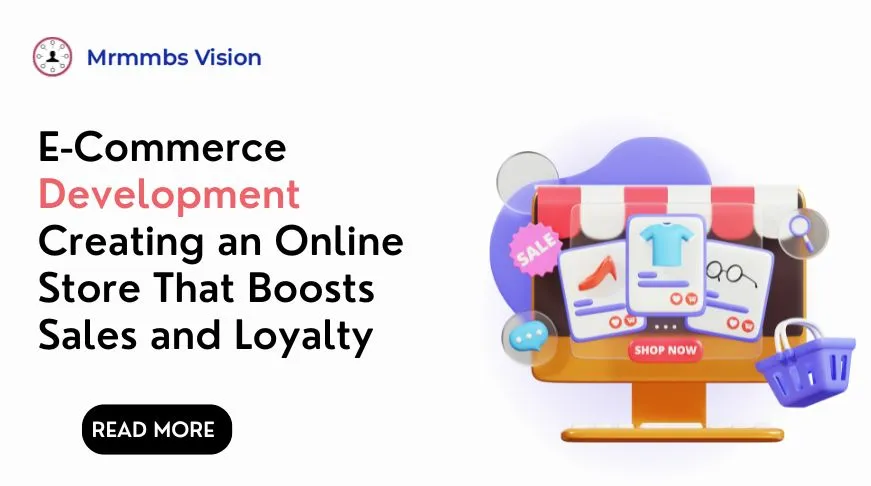
E-Commerce Development: Creating an Online Store That Boosts Sales and Loyalty
E-Commerce Development: Boosts Your Sales and Loyalty
Introduction
The digital age has brought about a transformation in the way we shop, transforming brick-and-mortar stores into vibrant online markets. E-commerce has become the foundation of modern retail, providing exceptional ease and a diverse range of products at customers' fingertips. As more people enjoy online purchasing, businesses must adapt and prosper in this ever-expanding digital landscape. This blog is the complete guide to creating an online store that not only attracts visitors but also turns them into repeat customers.
1- Laying the Groundwork with a Solid E-commerce Strategy
In this chapter, we underline the significance of starting with a clear e-commerce strategy. Market research can assist uncover possible niches and target markets. Analyzing competitors allows you to better grasp the market and find your store's unique selling qualities. A solid e-commerce strategy will define your brand's positioning, product offerings, pricing, and marketing approach. Having a clear plan from the start lays the groundwork for a successful online store.
2- Designing for Impact: creating an Intuitive and User-Friendly Interface
First impressions are critical to e-commerce success. In this chapter, we look at the role of design in producing a user-friendly interface. We talk about the most recent trends in e-commerce design, such as simple layouts, eye-catching images, and easy navigation. We particularly underline the importance of mobile responsiveness, as mobile devices account for a major portion of e-commerce traffic. By designing an appealing and user-friendly interface, you can capture customers' attention and keep them interested throughout their purchasing experience.
3- Behind the Scenes: selecting the Right E-commerce Platform
Choosing the right e-commerce platform is an important decision. In this chapter, we will compare prominent systems like Shopify, WooCommerce, Magento, and BigCommerce. We talk about their capabilities, customization choices, scalability, and integration with other programs. Understanding the pros and drawbacks of each platform allows you to make an informed decision based on your store's unique needs and long-term objectives.
4- The Power of Product Pages: Convincing Customers to Click on Buy Button
Product pages are essential for persuading customers to buy. This chapter delves into tactics for writing interesting product descriptions, high-quality photos, and customer reviews. We discuss the necessity of addressing customer pain areas and emphasizing product benefits. In addition, we explore cross-selling and upselling strategies for increasing average order value and customer satisfaction.
5- Mastering E-commerce SEO: Increase Organic Traffic to Your Store
A physically appealing store will not produce results if customers are unable to find it. This chapter focuses on e-commerce SEO (search engine optimization). We cover how keyword research, on-page optimization, and backlink development can help enhance search engine ranks. By understanding SEO strategies, you may generate organic search engine traffic and reach out to potential buyers who are actively looking for products like yours.
6- Mastering Content Marketing: Engaging Customers Beyond Transactions
In this chapter, we will look at how content marketing may help e-commerce businesses succeed. Content marketing is more than just promoting things; it's about engaging customers and creating a community around your brand. We cover how blogs, videos, and social media can help drive visitors to your store. By delivering valuable content, you may establish your brand as an expert in your area and build long-term client relationships.
7- Guiding the World of E-commerce Advertising
While organic traffic is crucial, advertising may dramatically enhance your online store's visibility. In this chapter, we walk you through the various e-commerce advertising platforms. We look at the tactics and best practices for conducting effective Google Ads, Facebook Ads, and influencer marketing campaigns. By intelligently allocating your advertising budget, you may effectively reach your target demographic while also achieving a high ROI.
8- The Checkout Experience: Optimizing for Conversions
The checkout experience is essential for converting visitors into clients. In this chapter, we look at how to improve the checkout experience, reduce cart abandonment, and develop customer trust. We talk about the importance of a clear and simple checkout procedure, as well as secure payment channels. By delivering a frictionless checkout experience, you enhance conversions and build client loyalty.
Conclusion
To summarize, creating a successful e-commerce site involves a strategic approach that includes research, design, marketing, and a focus on customer experience. By adopting the ideas and tips given in this article, you'll be well-equipped to build an online store that not only attracts visitors but also turns them into loyal customers. Embrace the e-commerce revolution and take your business to new heights in the digital realm!
Posted By: Mrmmbs Vision